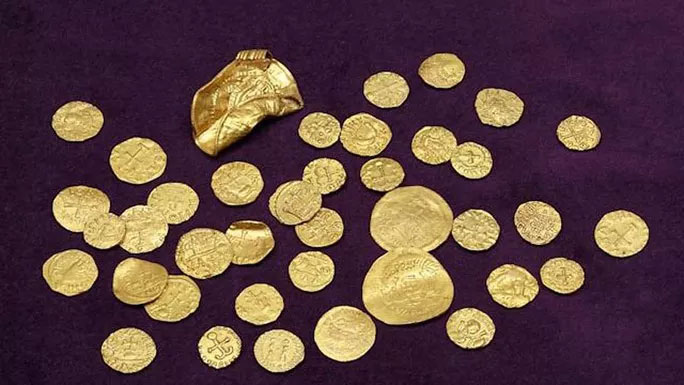Excavation, accidentally found the largest 1,400-year-old gold treasure in England
With a date of 1,400 years, the sophistication and historical significance of gold coins, Anglo-Saxon treasure has just been found in Norfolk (England) of enormous value, many times greater than the amount of gold that created it. .
According to the Evening Standard, the treasure consists of 131 gold coins and four other objects, also in gold, unearthed over a large area between 2014 and 2020. The coins were revealed when the field next to them was discovered. on it is plowed. An anonymous metal detector tried to track down and collect each artifact.

Some artifacts from the newly announced treasure - (Photo: British Museum)
Most of the coins are of the same mold and other gold objects show signs that they belong to the same treasury. The official burial site is believed to be near the grave of an ancient ruler in an area called "Sutton Hoo" , where the lord - or king - was found in a large ship with burial paraphernalia. worth a treasure.
Sheet Ancient Origins said first coin actually has exposed since 1991, but until 2014, when a few more coins appear, people really pay attention.
According to Dr Adrian Marsden from the Norfolk Historical and Environment Agency, there are a few coins in the treasure that were minted by the Byzantine Empire, but most were made by the Merovingian dynasty, which corresponds to present-day France. At this time in history, England did not mint its own gold coins, so the money had to be brought in from elsewhere in Europe.
The peculiarity of these coins is that the coins are in the same mold as other coins in a wallet also unearthed at Sutton Hoo, so the entire treasure may belong to the same Englishman who frequented the ancient Merovingian .
However, the whole of Sutton Hoo was plowed and turned upside down by farming for many years, before it was discovered to contain great treasures, thus identifying the treasure as belonging to the lord of the The aforementioned boat grave or someone else's burial nearby would be quite difficult.
According to Dr. Gareth Williams, curator of medieval coins at the British Museum, the discovery is extremely important and could help change the way we understand the economy of early Anglo-Saxon England. This treasure, if properly valued, could be Britain's largest treasure.
- Gold treasure excavation in Jerusalem
- Detecting Viking gold treasure with metal detector
- Discover the largest gold vault in the UK
- The American farmer quit his job to find a treasure of 40 tons of gold and silver
- The Viking warrior's silver and gold warehouse was discovered
- Carry out excavation of shipwrecks containing gold
- Excavation of the largest gold and ancient silver vault
- Gold jewelry set 2,500 years on the British field
- Excavation of 2000-year-old gold warehouse
- He: Accidentally found an extremely rare ancient gold ring in the field
- Discovering 700-year-old gold vault
- Found the Viking's huge treasure in England
 Discovered an ancient centipede fossil 99 million years old
Discovered an ancient centipede fossil 99 million years old Discovered bat-like dinosaurs in China
Discovered bat-like dinosaurs in China Discovered a 200-year-old bronze cannon of the coast
Discovered a 200-year-old bronze cannon of the coast Discover 305 million-year-old spider fossils
Discover 305 million-year-old spider fossils